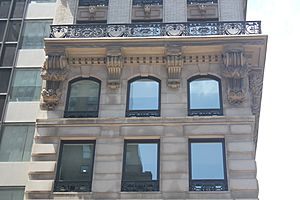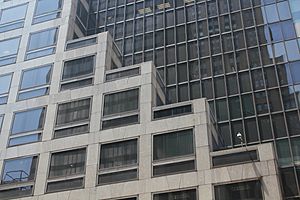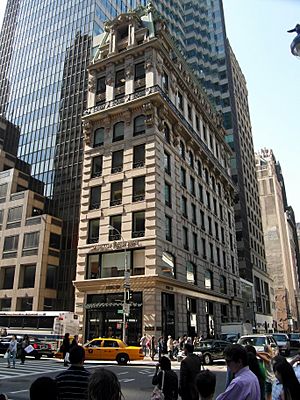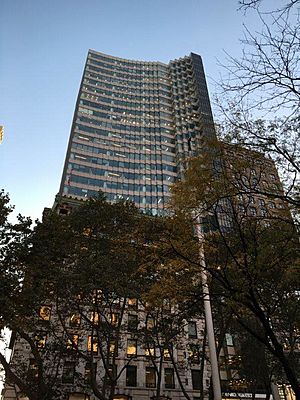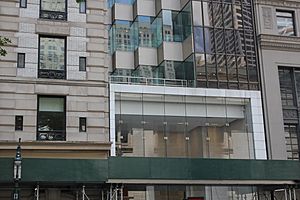452 Fifth Avenue facts for kids
Quick facts for kids 452 Fifth Avenue |
|
|---|---|
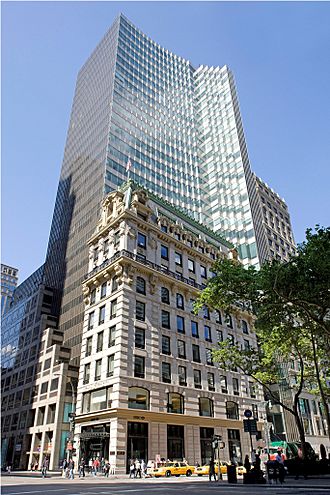 |
|
| Former names | Republic National Bank of New York Building, Knox Building |
| Alternative names | HSBC Tower |
| General information | |
| Status | Complete |
| Architectural style | Modernism |
| Location | 452 Fifth Avenue (1 West 39th Street) Manhattan, New York |
| Coordinates | 40°45′08″N 73°58′57″W / 40.75222°N 73.98250°W |
| Construction started | 1980 |
| Completed | 1985 |
| Owner | Property & Building Corporation |
| Height | |
| Roof | 400 feet (121.9 m) |
| Technical details | |
| Floor count | 30 |
| Floor area | 863,000 sq ft (80,200 m2) |
| Design and construction | |
| Architect | Eli Attia Architects |
|
Knox Building
|
|
| Location | 452 5th Ave., New York, New York |
| Area | less than one acre |
| Built | 1901 |
| Architect | Duncan,John H. |
| Architectural style | Beaux Arts |
| NRHP reference No. | 82003381 |
| Significant dates | |
| Added to NRHP | June 3, 1982 |
452 Fifth Avenue is a tall office building in Midtown Manhattan, New York City. It's also known as the HSBC Tower. This building is special because it combines an old, beautiful building with a modern skyscraper.
The building has two main parts. The front part, facing Fifth Avenue, is the 10-story Knox Building. It was built in 1902 and has a classic style called Beaux-Arts. Behind it rises the 30-story HSBC Tower, which was finished in 1985. It has a sleek glass design.
The Knox Building is very important. It's a New York City landmark and is listed on the National Register of Historic Places. This means its unique look is protected. The new HSBC Tower was designed to curve around the older Knox Building, making them fit together.
The Knox Building was first built for the Knox Hat Company. Later, it became the headquarters for the Republic National Bank. This bank then decided to build the large tower around the old building to create a new, bigger headquarters.
Contents
Exploring the Building's Location
This amazing building is located on the west side of Fifth Avenue in Midtown Manhattan. It sits between 39th and 40th Streets. The building is shaped like an "L" and covers a large area.
Right across 40th Street to the north is Bryant Park, a popular green space. The building is also near other famous New York City landmarks. These include the New York Public Library Main Branch and the Lord & Taylor Building.
The older Knox Building part sits at the corner of Fifth Avenue and 40th Street. It replaced an old house that used to be there. In the early 1900s, this area of Fifth Avenue was becoming a popular shopping district. Many new stores were built, replacing older homes.
The modern skyscraper also includes parts of other older buildings. One of these was the Kress Building, which was built in the 1930s in the Art Deco style. Another was the Willkie Memorial Building on 40th Street.
Understanding the Architecture
The building at 452 Fifth Avenue is actually made up of four different parts. The main parts are the 10-story Knox Building and the 30-story HSBC Tower. The Knox Building was designed by John H. Duncan in the Beaux-Arts style. The newer HSBC Tower was designed by Attia & Perkins.
The entire building is about 400 feet (120 m) tall. The Knox Building is a protected landmark, meaning its original design is kept safe. However, the Kress Building, another part of the complex, was not considered as important architecturally, so its look was changed.
The Building's Outer Look
Knox Building's Design
The outside of the Knox Building still looks much like it did when it was first built. The first six floors are covered with rough-cut limestone blocks on Fifth Avenue. On 40th Street, the lower floors use brick that looks similar.
The first floor has large display windows. The main entrance on Fifth Avenue has a fancy iron and glass cover. Above the first floor, there's a simple decorative ledge called a cornice. The windows on the second floor have special decorations above them.
The floors from the third to the eighth have detailed window designs. The third to sixth floors have three windows on Fifth Avenue and eight on 40th Street. The corners of the building have decorative stone blocks called quoins. Above the sixth floor, there's another large cornice with tooth-like shapes called dentils and big support brackets.
The seventh and eighth floors have windows between vertical brick sections and horizontal decorated panels. These panels are adorned with lion heads and fancy designs. Another cornice runs above the eighth floor.
The very top of the Knox Building has a tall, sloped roof called a mansard roof. This roof has windows that stick out, called dormer windows. The central dormer on Fifth Avenue is very large and has a pointed top with a female head. The top of the mansard roof has decorative metalwork with torches and eagle designs.
HSBC Tower's Modern Look
The HSBC Tower has a modern glass exterior. On its north side, the glass curves around the Knox Building. This makes the tower look like it has an unusual, stepped roof. The side facing Fifth Avenue has bronze-tinted glass to match other buildings nearby.
The side facing 40th Street has clear glass panels that give it a green tint. This green color was chosen to go well with the older Knox Building. The tower's glass walls don't have outside vertical bars; instead, they are held up by glass supports inside.
The HSBC Tower is set back about 10 feet (3.0 m) from the old building's street-facing walls. This design makes the tower look like a separate structure rising behind the Knox Building's mansard roof. There were plans for a similar curved tower across Fifth Avenue, but it was never built.
The tower also extends over the Kress Building on the 39th Street side. The Kress Building's original outside was completely changed when the new tower was built. It was replaced with granite in rose, beige, and gray colors. This new facade looks like a staircase going up from north to south. The Kress Building's original decorations were saved and put into storage.
Inside the Building
The different parts of 452 Fifth Avenue have large floor areas. This allowed the original bank, Republic National Bank, to put many of its departments on their own floors. When finished, the building had over 804,000 square feet (74,700 m2) of space.
The building has large bank vaults 50 feet (15 m) underground. The main entrance lobby is on 40th Street. It has tall glass walls and a special entrance cover. The lobby is decorated with stone and glass. There's also a banking area on Fifth Avenue for quick transactions. This area has unique globe-shaped chandeliers.
The lower floors of the HSBC Tower are connected to the old Knox Building. Glass hallways connect the two parts, making it feel like you're crossing bridges between them. The Kress Building was also expanded by two floors, adding a terrace on its roof. These new floors were used as a large trading floor for the bank.
The 11th floor of the HSBC Tower was designed as an executive dining room. It was decorated with artwork from the bank's collection. The main dining room used original wall panels from the Knox Building's old banking hall. The floors above the 12th story are smaller. Some of the top floors were originally executive offices but were later changed to regular offices due to the bank's growth.
Building's History
The Original Knox Building
The story of this building starts with Charles Knox, who founded the Knox Hat Company in 1838. His company became famous for high-quality hats. Later, his son, Edward M. Knox, took over the business. By 1900, Knox hats were known all over the world.
Building the Knox Hat Store
In 1901, Edward Knox bought the land at Fifth Avenue and 40th Street. This spot was across from where the New York Public Library Main Branch would later be built. Knox hired John Duncan to design a new 10-story building there.
The Knox Building was finished in October 1902. It had a beautiful Knox hat store on the ground floor. The store was decorated with carved walnut, mirrors, and bronze counters. It was a very fancy place. The New-York Tribune newspaper called it "one of the chief features of the avenue." Knox's hat company offices were in the building, and other parts were rented out to different businesses.
Over the years, many different tenants used the Knox Building. These included a photography studio, a publishing company, and even the Republican National Committee for a short time.
Mid-20th Century Changes
In the 1920s, the building's ownership changed, and it was renovated. Famous real estate investor August Heckscher bought the leasehold in 1922. The Knox Hat Company continued to rent space there, even setting a record for rent on Fifth Avenue.
In 1964, the Knox family sold the building to a group that started the Republic National Bank of New York. The bank made the Knox Building its headquarters. They renovated the inside but kept the outside mostly the same to preserve its beauty. The bank officially opened its space in the Knox Building in January 1966.
Developing the Tower
Starting around 1970, Republic Bank bought up more land around the Knox Building. This included the Kress Building and other structures. The bank planned to build a large new headquarters tower to bring all its operations together.
Construction of the Tower
The bank wanted to keep the Knox Building and other older structures because some of their operations couldn't stop. They also didn't want the new tower to hide the beautiful design of the Knox Building. In 1978, Republic Bank hired several architecture firms to design the new tower.
In 1980, the Knox Building was officially named a city landmark. This meant its design was protected, and major changes needed approval. The bank eventually supported this landmark status. In 1981, Attia Architects presented plans for a 27-story tower that would wrap around the Knox Building. This was a huge project for Fifth Avenue. In 1983, the bank added two more stories to the plan without making the building taller.
Turner Construction was the main company building the tower. The Knox Building was carefully restored as part of the project. Some original features that had been removed in the 1960s were put back. The inside of the Knox Building was completely rebuilt. The Kress Building's outside was also replaced.
Completion and Growth
The Republic National Bank Tower was finished by late 1985. It cost about $100 million. The bank initially planned to use only the lower floors but ended up leasing more space. Other companies also rented floors in the new tower.
By the early 1990s, Republic Bank had grown so much that it needed even more space. In 1993, the bank proposed adding a 16-story building next to the tower. This addition would connect to the existing tower and the Knox Building. After some changes, the plan was approved.
In 1994, New York City offered financial help to build the new addition. This included tax breaks and bonds. The bank decided to keep its data center in the city instead of moving it to New Jersey. The work on the data center and the adjacent building was completed in the late 1990s.
The 21st Century Building
In 1999, HSBC, a large international bank, bought Republic National Bank. HSBC Brokerage expanded its offices at 452 Fifth Avenue in 2002.
In 2008, HSBC thought about selling the building but decided not to. By 2009, they were considering selling it again. In October 2009, HSBC Holdings sold the building to Midtown Equities and IDB Group for $352.9 million. HSBC planned to rent back parts of the building. IDB then gave the building to its subsidiary, Property & Building Corporation (PBC).
After the sale, PBC started renovating the HSBC Tower in 2010. They restored some of the original decorations on the Knox Building. The lobby was refurbished in 2011, and elevators and other equipment were updated. By late 2012, the renovations were almost finished.
By 2013, renting space in 452 Fifth Avenue became very expensive, showing how popular the building was. By 2015, the building was fully leased. In 2017, HSBC Bank extended its lease for another five years, showing it still wanted to stay in this unique and historic building.
|
See also
 In Spanish: HSBC Tower (Midtown Manhattan) para niños
In Spanish: HSBC Tower (Midtown Manhattan) para niños


